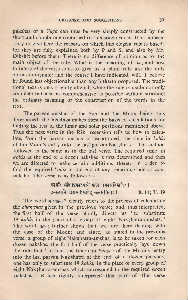Page 685 - Lokmanya Tilak Samagra (khand 2)
P. 685
CRITICISM AND SUGGESTIONS 37
pakshas of a Yuga can thus be very simply constructed by the
short and simple rule contained in this single verse. It is unnece-
ssary to give here the reasons on which this elegent rule is based;
for they are fully explained both by B and S, and also by Mr.
Dikshit before them. There is no difference of opinion as to the
main object of the rule. What is the meaning of ~. and how
to interpret the verse so as to give us a plain rule are the only
points in dispute; and the course I have indicated, will, I believe
be found less objectionable than any hitherto proposed. The tradi-
tional text is only slightly altered, while the rule is made not only
complete but also as comprehensive as possible without straining
the ordinary meaning or the construction of the words in the
text.
The parvan amshas of the Sun and the Moon being thus
determined, the Vedanga makes them the basis of calculations for
finding the rest of the lunar and solar positions mentioned above.
Thus the next verse in the Rik recension tells us how to calcu-
late, from the parvan-amshas so ascertained, the time in kalds
of the Moon's entry into the last parvan Nak~hatra. The method
followed is the same as in the last verse. The required time in
kalds at the end of a dozen pakshas is first determined and then
we are directed to make certain additions thereto in order to
find the required kalds at the end of any remaining odd or una-
paksha. The verse is as follows :-
~T~: ~~~~ Cf.<:lT t:J::Cf.T~feima: I
~~ ~oa1<i~q~ ~~fq<:fT: II R.ll; Y. 19
The word +l~~T 0 clearly refers to the process of calculating
the bhamshas given in the previous verse; and, thus interpreted,
the first half of the verse plainly directs us ' to substitute
19 kalds in the place of a group of eight Nak~hatra-amshas. •
The word ~r: further shows that we are here dealing with
the case of the Moon; and since, as stated in the previous
verse, a group of eight Nak~Jhatra-amshas, is to be taken for each
dozen pakshas, the first half of the verse practically lays down
the rule that ' to find the time ( in kahis) of the Moon's entry
into the last parvan Nak~Jhatra at the end of a dozen pakshas,
one has only to substitute 19 kalds, in the place of every group of
eight Nak~Jhatra-amshas which correspond to the required dozen
pakshas. ' B has rightly interpreted this part of the verse

